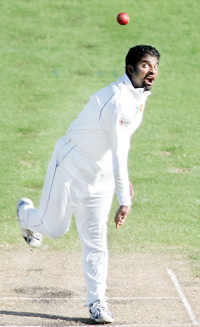Fast bowlers, they say, hunt in pairs. Looking back at test cricket during the last century, the exploits of Larwood and Voce, Lindwall and Miller, Tyson and Statham, Lillee and Thomson – to name but a few – were awe inspiring.
 |
| Shane Warne |
The West Indians had Roberts and Holding in the late 1970s, but skipper Lloyd did a different take when he opted for a four pronged pace attack. This decision was influenced by the failure of his spinners Jumadeen and Insham Ali to defend a four hundred plus total against India. The mean machine, as it was referred to, swept everything in its wake. It was unrelenting pace like fire, replete with perfume balls – that the over-rate suffered dramatically was a different matter. The ‘quicks’ from the Caribbean could always claim that the job was over and done with well ahead of time.
Pure pace seemed to be the preserve of the white nations and those from the Caribbean, until the likes of Imran Khan,Kapil Dev, Wasim Akram,Waqar Younis and Shoaib Akthar appeared on the scene. The combination of Wasim and Waqar was particularly heady cocktail, the former with his pace, bounce and lethal swing: the latter with his toe-crushing yorkers.
The Asian countries have always set great store by spin. In the 1970s the openers opened the attack for India with their gentle dobbers, only for the spin quartet of Bedi, Prasanna, Chandrasekhar and Venkataraghavan to take over after an over or two.
Sri Lanka, in their initial foray in test cricket, had the pace of de Mel supplemented by the spin of the de Silva and Kaluperuma. Spin clinics have been held from time to time, but due to the efforts of Rumesh Ratnayake, initially, and now of Ramanayake, many fast to medium bowlers have come through. In consequence, Sri Lanka like most other countries, don’t use a spin pairing.
 |
| Muttiah Muralitharan |
Currently, Pakistan employs the spin combination of Ajmal and Rehman especially when playing on desert sands. The absence of quality fast bowlers has led to the eminently sensible decision by Bangladesh of placing their trust in spin. The success of Shakib Al Hassan has confirmed that the spin option was the best one.
The one spinner policy followed by Australia worked wonderfully well in the time of Warne. A quality bowler who could bowl long spells, Warne had the likes of McGrath, Gillespie and Mev Hughes in support. In Sri Lanka Murali often ploughed a lonely furrow, not having a spin partner to support him consistently. But Murali was a one off who thought nothing of bowling forty overs in his unquenchable thirst for wickets. Vaas, a different kettle of fish, bowled in tandem with Murali but wasn’t a typical pairing.
Sri Lanka is finding it difficult to win matches even on home soil in the post Murali era. The three pacemen formula has not produced significant success. Barring Welagedera, no one seems to be injury free. Should Sri Lanka go back to spinning tracks and greater emphasis on spin. Perish the thought! But where are the quality spinners? Latterly Mendis and Randika have not been given adequate exposure and their progress appears to have been stunted. Spin bowlers maturing late is a truism but they have to bowl hundreds of overs in the meantime.
When Warne (708 wickets at 25.41) and Anil Kumble (619 wickets at 29.65) were in their pomp, cricket was a different game. Flight, turn and variation were used to deceive and bamboozle. It was a case of killing the opposing batsman softly. Cricket then provided a different kind of entertainment – no throat balls, no perfume balls and no toe shredding yorkers. The extinction of the classical leg spinner is indeed sad.
As a breed, the off spinners, however successful, are less captivating and entrancing. Harbhajan (408 wickets at 32.22) and Graeme Swann (153 at 28.82) are the leading purveyors of this art. However, there is a cloud hovering over the former and the latter having come on the scene late will have a short shelf life.
The variation provided by the Doosra is unique and thought provoking to the batsmen. A fascinating diversion, there is a school of thought that believes a Doosra can never be bowled without infringing the law. Bishen Singh Bedi, always outspoken and controversial, can claim in his defense that his action was classical and pure.
At school level and even at club level in Sri Lanka, the left arm spinner is quite often the fulcrum of the attack. Daniel Vettori (355 wickets at 33.67), Rangana Herath (119 at 43.24) and Shakib Al Hassan are the present practitioners of the art at international level – not forgetting Ray Price and Abdur Rahman. A left arm spinner or a right arm leggie bowling over after over against a top flight batsman prepared to come down the track to him makes for a fascinating contest.
In conclusion, long may the spinner thrive even if he, like Nathan Lyon, is there merely to provide a welcome diversion. |



